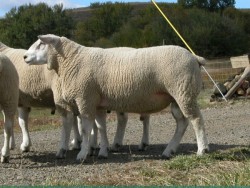By Chloe Mitchell, ASAS/ASAP communications intern
Animal Production 2016 speaker highlight: Joanne Conington

Texel sheep
Footrot is an endemic disease of sheep, causing not only pain to the animal but also significant reduction in production as well as economic losses to the UK sheep industry.
As footrot is highly contagious, its economic impacts are severe. There are major labour costs involved in management of the disease, as well as costs for prophylactic and veterinary treatment and the indirect costs incurred through reduction in sheep milk production, reduced fertility and other production losses.
There is, however, the potential to exploit host genetic resistance to footrot as a potential breeding opportunity to manage and control the disease. Footrot is moderately heritable, giving the possibility for genetic manipulation in resistance and susceptibility to the disease.
Conington and colleagues used data from Texel sheep, phenotyped for footrot. Of a population of 2229 sheep, a subset of 336 were genotyped as these animals had extreme trait values for footrot. Breeding values for footrot were used as “pseudo-phenotypes” for a genome-wide association study.
The study identified seven single nucleotide polymorphisms that were significant on a chromosome level, however no major genome level significant quantitative trait loci were identified. These findings suggest that susceptibility or resistance to footrot is likely determined by multiple genes, as no major genes were identified as responsible. These results should be treated as an initial step towards identifying genomic regions associated with footrot.
Access the full article here.




